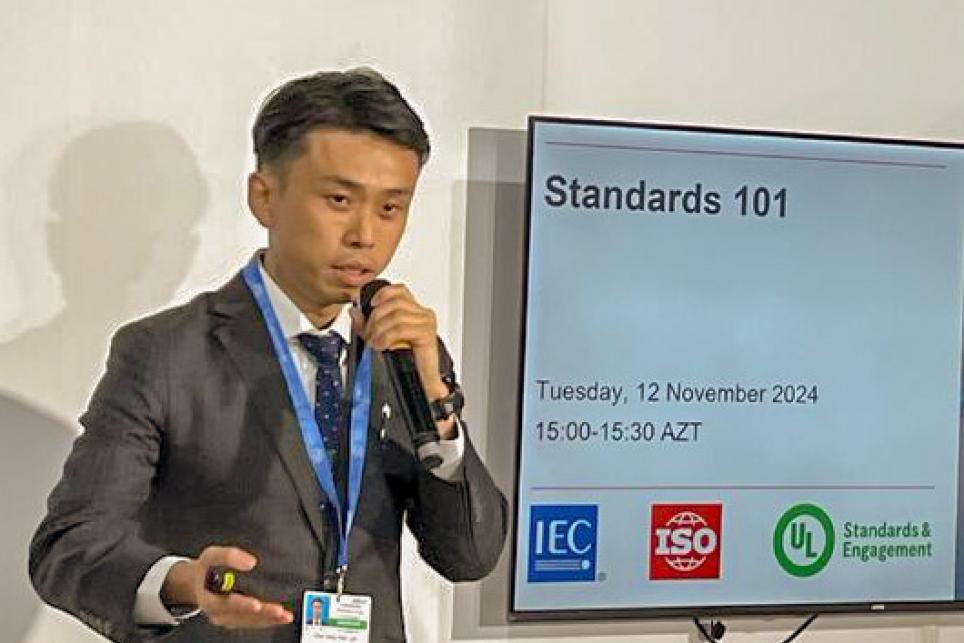-
Perspectives
December 13, 2024
Delivering on the Promise of the UL Mission at COP29

By Kolin Low, Regional Director
When we talk about the UL mission—working for a safer world—one might conclude that ‘safety’ refers to a 130-year legacy of addressing risks and hazards for products and systems. And that’s true—it’s what the organization is most known for.
However, there is much more to our safety mission. For instance, we also work for the safety of future generations through efforts to address the impacts of climate change and supporting the transition to clean energy and other sustainability initiatives.
This was our purpose at COP29: to elevate the role of standards as part of a multifaceted approach to addressing climate change and its effects.
UL Standards & Engagement partnered with IEC and ISO—along with other organizations—to co-host the first Standards Pavilion at COP29. Climate change is a global crisis, and therefore international collaboration driving globally focused solutions is the key to achieving impact. The energy and discussions in Baku gave me great confidence.
Mission focus
As I noted above, climate change is highly relevant to our mission. Our standards portfolio works in two ways to address the crisis: adaptation and mitigation.
We know that the effects of climate change are not a future problem. Powerful storms, wildfires, droughts, and more are affecting more of the world, more frequently, and with increasing intensity right now. As a result, we need immediate solutions for adaptation—and standards supporting greater resilience of our built environment is essential. We are updating standards for construction materials as well as energy systems and more for resilience. For example, enhanced requirements to make homes less susceptible to the spread of flames during a wildfire or better able to withstand extreme temperatures or other conditions.

Our mitigation approach includes our work to standardize components for clean energy and sustainable practices and products. My ULSE colleague, Caitlin D’Onofrio, senior program manager, leads our sustainability program and also presented in multiple sessions at COP29. Her team maintains UL 3600, which provides a framework for measuring and reporting circular economy efforts – an excellent example of how standards can be applied to sustainability to assure trust, just as they do for products and systems. There are myriad other ways our standards support sustainability. For example, we publish a range of standards for the green energy ecosystem ranging from solar panels and wind turbines to energy storage systems.
Together with our peers at UL Research Institutes and UL Solutions, we apply safety science to achieve our shared mission.
Partnerships are a critical path
Expanding on the notion of international collaboration as paramount to achieving impact on climate change, I was very proud to have partnered with IEC and ISO at the Standards Pavilion. Our organizations—and other standards development organizations throughout the world—have the tremendous opportunity to establish a coherent and united approach to demonstrate the power of standards.
Besides directly addressing requirements to enhance adaptation and mitigation, standards have the unique ability to provide other benefits that optimize international application, such as:
- Enhanced regulatory efficiency
- Common language and best practices guiding sustainability initiatives
- Assurance and trust based on extensive collaboration and knowledge sharing
It’s also important that SDOs collaborate upstream and downstream in the quality infrastructure network to achieve our shared vision. Our peers in metrology, accreditation, and conformity assessment play essential roles in the application and implementation of our work.
Conclusion
Ultimately, international standards provide the best means to have an impactful and streamlined application to address climate change and its effects. The trust and assurance that standards provide come through partnerships, knowledge sharing and collaboration by a diverse group of subject matter experts, and a track record of impact across industries.
In its first year, the Standards Pavilion at COP29 hosted a strong program of expert speakers discussing critical topics to help achieve its objective of establishing standardization as a means of addressing the world’s climate crisis. I felt a great sense of validation in the work ULSE is doing in support of sustainability.
And finally, COP29 was a great opportunity for UL Standards & Engagement to contribute to the international standardization framework with our partners from IEC, ISO, and our other partners at the Standards Pavilion. This was a remarkably proud experience for our organization; upon which we build to continue enhancing and expanding our work for a safer—and more sustainable—world.